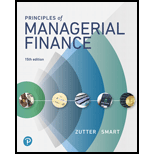
Learning Goals 5, 6
ST6- 1
- a. If interest is paid annually, find the value of the bond when the required return is (1) 7%, (2) 8%, and (3) 10%.
- b. Indicate for each case in part a whether the bond is selling at a discount, at a premium, or at its par value.
- c. Using the 10% required return, find the bond’s value when interest is paid semiannually.
Subpart (a)
To calculate: Valuation of bond.
Introduction:
Bond valuation: Determining the theoretical fair value of a particular bond is known as bond valuation.
Answer to Problem 6.1STP
At 7% required return = $1,079.43
At 8% required return = $1.000
At 10% required return = $863.80
Explanation of Solution
Given:
(1)
I (interest) = 0.8%
n (years to maturity) = 12
M (dollar par value) = $1000
rd (required return on the bond) = 7%
(2)
I (interest) = 0.8%
n (years to maturity) = 12
M (dollar par value) = $1000
rd (required return on the bond) = 8%
(3)
I (interest) = 0.8%
n (years to maturity) = 12
M (dollar par value) = $1000
rd (required return on the bond) = 10%
Calculation
The general formula for calculating bond valuation in annually is shown below.
Substitute the values in equation (1) to calculate the valuation of bond. Here the interest rate is $80 of interest (0.08 multiplied by $1000).
Valuation of bond is $1,079.43.
By using the same equation (1), the valuation of bond in different interest rate is shown below.
Table 1 shows the valuation of bond.
Table 1
| I | M | N | rd | Bond valuation | |
| 1 | $80 | $1000 | 12 | 0.07 | $1,079.43 |
| 2 | $80 | $1000 | 12 | 0.08 | $1,000.00 |
| 3 | $80 | $1000 | 12 | 0.10 | $863.80 |
Subpart (b)
To discuss: Classify the bond as, sale in discount, premium or at its par value.
Explanation of Solution
On the basis of required return and valuation, the bonds are classified as sale in discount, sale in premium or sale in its par value. The bond which has 7% return and $1, 079, 43 bond value is sells at premium. The second bond (8% return and $1,000.00 bond value) is sells at its par value and third bond (10% return and $863.80 bond value) is sells at discount.
Subpart (c)
To calculate: Valuation of bond at semiannual interest payment.
Introduction:
Bond valuation: Determining the theoretical fair value of a particular bond is known as bond valuation.
Answer to Problem 6.1STP
$862.00
Explanation of Solution
Given:
rd (required return on the bond) = 10%
M (dollar par value) = $1000
n (years to maturity) = 12
I (interest) = 0.8%
Calculation
For calculating the value of bond in semiannual interest rate, convert the annual interest rate in to semiannual interest rate by dividing by two, likewise the required return and number of years to maturity must be divided and multiplied by two respectively.
By using the equation (1), in part (a), the calculation of valuation in semiannual interest payment is shown below.
Valuation of bond in semiannual interest payment is $862.00.
Want to see more full solutions like this?
Chapter 6 Solutions
Gitman: Principl Manageri Finance_15 (15th Edition) (What's New in Finance)
Additional Business Textbook Solutions
Financial Accounting, Student Value Edition (5th Edition)
Intermediate Accounting (2nd Edition)
Operations Management
Horngren's Cost Accounting: A Managerial Emphasis (16th Edition)
Operations Management: Processes and Supply Chains (12th Edition) (What's New in Operations Management)
Marketing: An Introduction (13th Edition)
- critically discuss the hockey stick model of a start-up financing. In your response, explain the model and discibe its three main stages, highlighting the key characteristics of each stage in terms of growth, risk, and funding expectations.arrow_forwardSolve this problem please .arrow_forwardSolve this finance question.arrow_forward
- solve this question.Pat and Chris have identical interest-bearing bank accounts that pay them $15 interest per year. Pat leaves the $15 in the account each year, while Chris takes the $15 home to a jar and never spends any of it. After five years, who has more money?arrow_forwardWhat is corporate finance? explain all thingsarrow_forwardSolve this finance problem.arrow_forward
 Essentials Of InvestmentsFinanceISBN:9781260013924Author:Bodie, Zvi, Kane, Alex, MARCUS, Alan J.Publisher:Mcgraw-hill Education,
Essentials Of InvestmentsFinanceISBN:9781260013924Author:Bodie, Zvi, Kane, Alex, MARCUS, Alan J.Publisher:Mcgraw-hill Education,

 Foundations Of FinanceFinanceISBN:9780134897264Author:KEOWN, Arthur J., Martin, John D., PETTY, J. WilliamPublisher:Pearson,
Foundations Of FinanceFinanceISBN:9780134897264Author:KEOWN, Arthur J., Martin, John D., PETTY, J. WilliamPublisher:Pearson, Fundamentals of Financial Management (MindTap Cou...FinanceISBN:9781337395250Author:Eugene F. Brigham, Joel F. HoustonPublisher:Cengage Learning
Fundamentals of Financial Management (MindTap Cou...FinanceISBN:9781337395250Author:Eugene F. Brigham, Joel F. HoustonPublisher:Cengage Learning Corporate Finance (The Mcgraw-hill/Irwin Series i...FinanceISBN:9780077861759Author:Stephen A. Ross Franco Modigliani Professor of Financial Economics Professor, Randolph W Westerfield Robert R. Dockson Deans Chair in Bus. Admin., Jeffrey Jaffe, Bradford D Jordan ProfessorPublisher:McGraw-Hill Education
Corporate Finance (The Mcgraw-hill/Irwin Series i...FinanceISBN:9780077861759Author:Stephen A. Ross Franco Modigliani Professor of Financial Economics Professor, Randolph W Westerfield Robert R. Dockson Deans Chair in Bus. Admin., Jeffrey Jaffe, Bradford D Jordan ProfessorPublisher:McGraw-Hill Education





